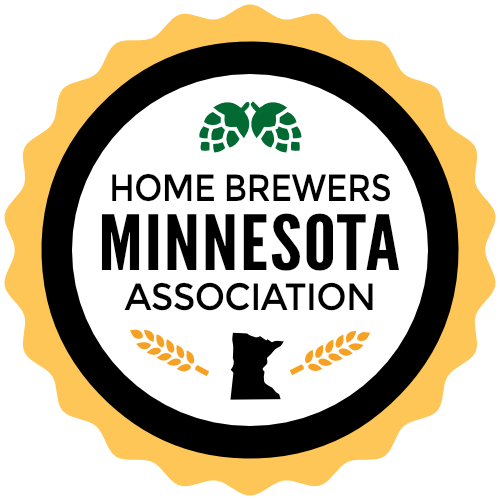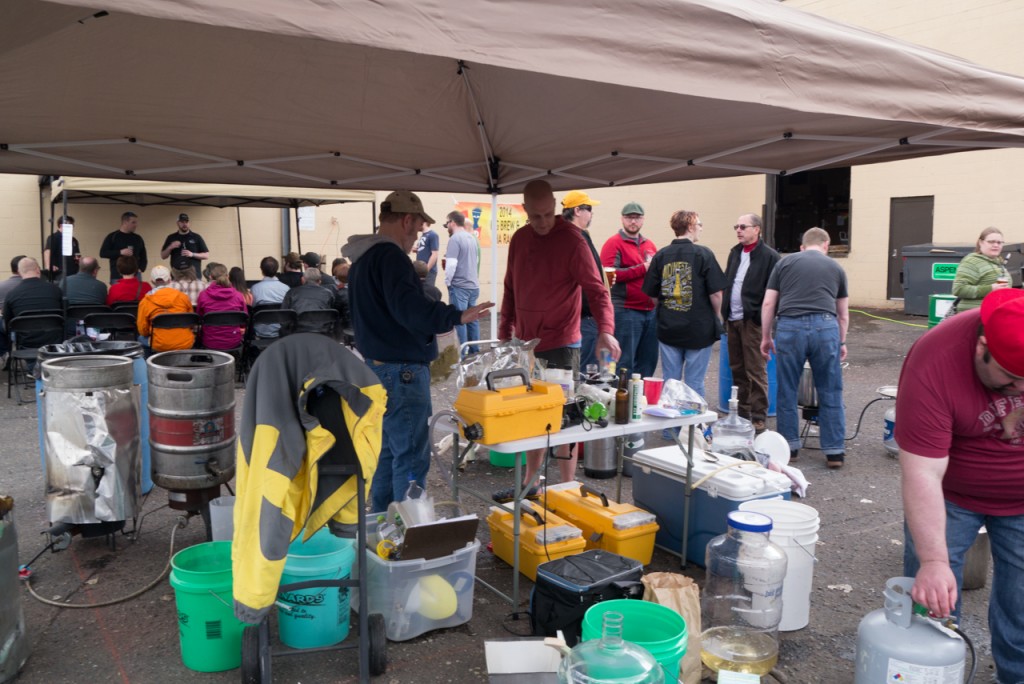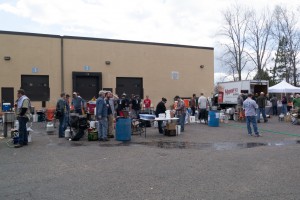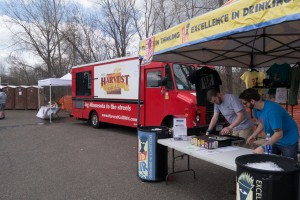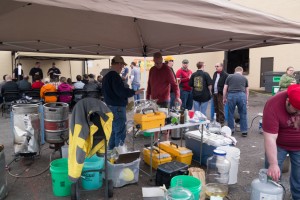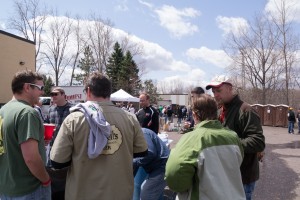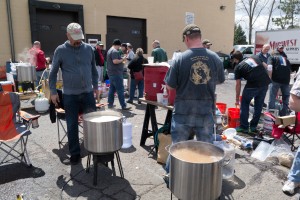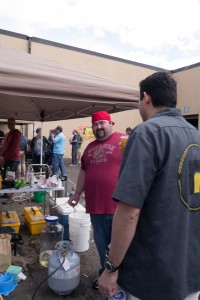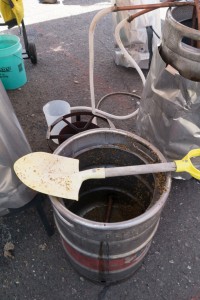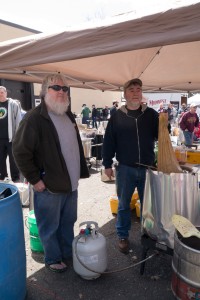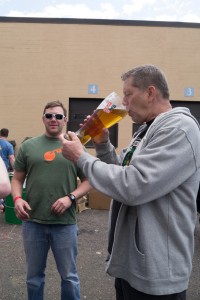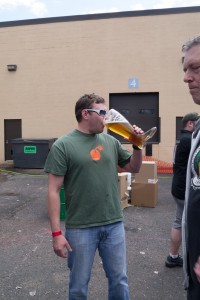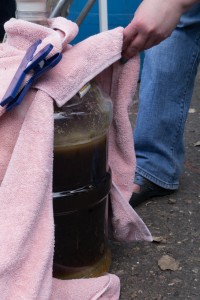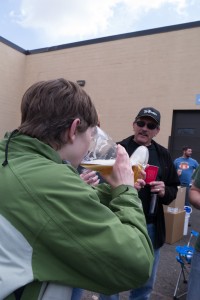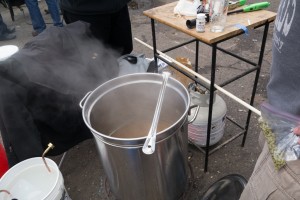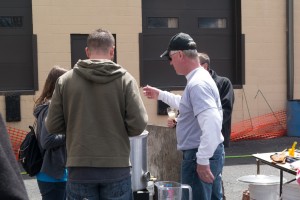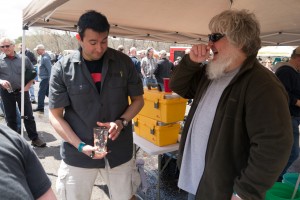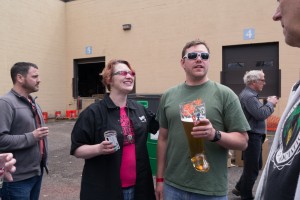David Royer
Congratulations to the Town Hall Brewery 1st Cider Competition winners!
Best of Show
First Place: Brett Glenna, 27A: Common Cider
Read MoreA quick reminder that Thursday, May 22 we will be gathering at Midway Stadium in St Paul to share home brew, enjoy some grilled brats, chat with friends…oh yah…and for a baseball game!
There are still a couple tickets available if you don’t have yours yet. You can purchase tickets on the event calendar page if you haven’t done so yet.
Once again the club will be providing a brat for all ticket holders. Please bring something to share as well as some home brew to show off! The details for time and location are available on the club calendar.
See you there!
Read MoreThe Minnesota Home Brewers Association has been invited by the brewer, Matt Asay, to check out the sake brewing operation at moto-i! If you have ever been interested in checking out what is involved with sake brewing, here’s your chance! Matt will share details of sake brewing as well as share samples! You can find all the details on the club calendar Event Page!
Read MoreSaturday, May 3 brewers from far and wide desended on Lucid Brewing for a homebrew double header.
Close to 50 individual brewers from numerous homebrew clubs throughout the state started the day with the annual American Homebrewers Association Big Brew Day. Big Brew Day encourages brewers to come together and brew batches of beer, share homebrew and learn from watching each other brew. In addition to huge amount of homebrewed beer, mead and cider being shared, Lucid provided food and beer for sale. While the brewing was happening, several seminars were taking place on all things brewing. Several of the seminars were put on by MHBA club members.
In the afternoon, the brewing was wrapping up but Lucid hosted an American Homebrewers Association Wort Rally where brewers who pre-registered could pick up 5 gallons of unfermented wort, brewed by Lucid, for free! The wort given away was an Imperial Black IPA coming in at 18° Plato, or about 1.078 OG.
A huge Thank You goes out to the entire crew at Lucid for planning and putting on this spectacular event!
Read MoreThe club is hosting a logo contest! We need an updated version of the logo that can be used in more places and on new schwag! Maybe you like the old logo? Maybe you have a fantastic idea for something new and unique. We need you to break out your crayons, digital stylus or anything in between and submit your design. Complete details, including information on how to submit, can be found on the logo contest announcement page.
Read Moreby Steve Piatz
This article originally appeared in the May 2009 newsletter of the Minnesota Home Brewers Association.
This month’s Style of the Month is for a Scottish 60 Shilling in preparation for the June meeting. The Scottish 60 Shilling will take about three to five days or so to ferment out. If you are bottle conditioning you should allow a couple of weeks for the bottles to carbonate. That means you really should get yours brewed in early May if you want it ready for the June meeting. Of course, you don’t have to bottle condition the beer so kegging it could save you a few weeks.
Description
From the description of the Scottish 60 Shilling in the BJCP Guidelines available at bjcp.org. Aroma: Low to medium malty sweetness, sometimes accentuated by low to moderate kettle caramelization. Some examples have a low hop aroma, light fruitiness, low diacetyl, and/or a low to moderate peaty aroma (all are optional). The peaty aroma is sometimes perceived as earthy, smoky or very lightly roasted. Appearance: Deep amber to dark copper. Usually very clear due to long, cool fermentations. Low to moderate, creamy off-white to light tan-colored head. Flavor: Malt is the primary flavor, but isn’t overly strong. The initial malty sweetness is usually accentuated by a low to moderate kettle caramelization, and is sometimes accompanied by a low diacetyl component. Fruity esters may be moderate to none. Hop bitterness is low to moderate, but the balance will always be towards the malt (although not always by much). Hop flavor is low to none. A low to moderate peaty character is optional, and may be perceived as earthy or smoky. Generally has a grainy, dry finish due to small amounts of unmalted roasted barley. Mouthfeel: Medium-low to medium body. Low to moderate carbonation. Sometimes a bit creamy, but often quite dry due to use of roasted barley. Overall Impression: Cleanly malty with a drying finish, perhaps a few esters, and on occasion a faint bit of peaty earthiness (smoke). Most beers finish fairly dry considering their relatively sweet palate, and as such have a different balance than strong Scotch ales.
There are no classic commercial examples of Scottish 60 Shilling available locally. The style does not travel well and is typically only available served from casks within the United Kingdom.
Scottish 60 Shilling
- OG: 1.030 – 1.035
- FG: 1.010 – 1.013
- SRM: 9 – 17
- IBU: 10 – 20
- ABV 2.5 – 3.2%
Background
The Scottish brewers were early adopters of technology such as the thermometer and the hydrometer. The Scottish brewers were also early adopters of sparging when the English brewers were still using double mashes. Double mashing means draining the mash tun into the kettle and then adding additional hot water to he mash, stirring, and draining again. Scottish brewers typically boiled the wort for 60 to 90 minute versus the English 180 minute boil of the same era. Scottish brewers were farther north, they fermented their ales as cool as 50° F. Whereas the English brewers allowed there ale ferments to go as warm as 70° F, Scottish ferments would rarely go above 65° F. The lower fermentation produces less esters in the beer and can leave a little diacetyl in the beer. The typical Scottish yeast strain tends to have a lower attenuation rate, so with the same original gravity as in an English beer the Scottish beer would finish a little sweeter. Many Scottish yeasts will take the beer only down to one third of the original gravity, i.e. OG 1.100 with a FG of 1.033; where most English ale yeasts would take the beer to one quarter of the original gravity, i.e. OG 1.100 with a FG of 1.025.
Many of the major Scottish breweries were/are situated in locations were the brewery can obtain multiple levels of dissolved minerals in the water by using different well depths. The typical Scottish ale uses relatively soft water. Hops were more expensive in Scotland than England or continental Europe because Scotland is too far north for cultivating hops. Like most commercial English brewers, the Scottish brewers frequently added adjuncts (sugar) to the kettle.
Today, the 60 Shilling beer (abbreviated as 60 /- for 60 shillings and zero pence) has an original gravity of about 1.034. The shilling number associated with a Scottish beer was the price per barrel of the beer. On any given day, as the number of shillings per barrel was increased the original gravity typically increased. For a fixed price of a barrel of beer, as the price of ingredients changed the original gravity of the beer changed. In 1850, a 60 shilling beer had an original gravity of 1.074. The use of peat-smoked malt in the Scottish beers is NOT appropriate. If there is a slight smoke character in the beer, it is likely from the yeast working at a low temperature.
The Recipe
The recipe target is for an original gravity of 1.034 and about 18 IBUs for 5.5 gallons of wort. That should give you a full five gallons of beer in the fermenter after the typical losses in the kettle. The process calls for a traditional Scottish technique: you want to intentionally caramelize a portion of the wort by taking about a gallon of the wort and boiling it until the color starts to darken before adding the caramelized portion back to the full boil.
This style can double as a yeast starter to grow a lot of yeast to ferment a big beer like a Strong Scotch Ale. Once you rack the the 60 /- off the yeast you can just run the chilled wort of the big beer into the fermenter.
All-Grain Version
The bulk of the grist is Pale Ale Malt. The roast barley is just to add a little depth to the color and a light dryness to the beer.
| Amount (lbs) | Ingredient |
|---|---|
| 6.50 | Pale Ale Malt |
| 0.16 | Roasted Barley |
Extract Version
For the extract version, replace the Pale Ale malt with the light extract.
| Amount (lbs) | Ingredient |
|---|---|
| 4 | Light Liquid Malt Extract |
| 0.16 | Roasted Barley |
If you do not have the ability to boil the full 7 gallons of wort in the extract recipe, try for the largest boil you can handle. If your boil volume is significantly below 7 gallons, you will probably want to increase the hop quantities. Remember, a partial boil is going to result in a slightly darker colored beer than you would get from the same ingredients used in a full volume boil.
Water
You should produce this beer with relatively soft to moderately hard water. With the highly alkaline (carbonate) water like from most of the deep wells in the Metro area, I would suggest blending your tap water with equal parts of distilled or reverse osmosis water to reduce the hardness.
The Boil
The hop bill is as follow:
| Amount (oz) | Hop Variety (pellets) | Time Left |
|---|---|---|
| 1.00 | East Kent Goldings 4.25%AA | 60 |
Post-Boil Processing and Fermentation
The yeast choices for the style include the Scottish strains White Labs Edinburgh Ale (WLP028) and Wyeast Scottish Ale (1728). No matter which yeast you select, you need to chill the wort to the suggested fermentation temperature range. Getting some oxygen into the chilled wort is a good idea, oxygen injection or even air from an aquarium pump with a sterile air filter can do the job. You can start the fermentation in to 50’s °F and let the temperature climb into the low to mid-60’s to keep the ester production low.
If you are bottle conditioning, bottle the beer after targeting about 2.0 volume of carbonation and then allow it to carbonate for a couple of weeks at room temperature.
References
Greg Noonan, Scotch Ale, Brewers Publications, 1993.
Recipe files
Scottish 60 Shilling recipe files:
We are looking to refresh and update the Minnesota Home Brewers Association’s logo!
Submission Guidelines
- The purpose of the contest is to design a logo for the Minnesota Home Brewers Association. The logo will be used online, in print, and on merchandise.
- Entry can be done in any media: electronic or created by hand.
- Flexibility is a key requirement: it needs to resize easily and to look good in black and white as well as color.
- Entry needs to be original and not in any way similar to existing logos or other copyrighted images.
- Entrant must have legal permission to use any components for the logo. Legally obtained or free clipart or stock images maybe used, but images from Google search may not.
- The logo must contain the words “Minnesota Home Brewers Association”.
- Paper entries must be on 8.5” x 11” and the logo must be at least 6” x 6”.
- Electronic entries can be any size or format.
Eligibility
- The contest is open only to individuals. It is not open to companies, educational institutions, organizations, etc. or to groups associated with such institutions.
- Entrant must be a current member of the MHBA.
- Entrants must be at least 21 years old.
- MHBA Board member may enter the contest, but he/she will be prohibited from the judging selection.
How to Enter
- Entries can be submitted by:
- Emailed to [email protected]
- On website at mnbrewers.com/logo-contest
- Mailed to MHBA Logo Contest c/o Gera Exire LaTour, 3757 Dupont Avenue N, Minneapolis, MN 55412
- The entry must include the name, age, postal address, phone number, and email address of the entrant.
- MHBA members can submit multiple entries.
- The deadline is midnight on May 23, 2014.
- There is no fee to enter the contest.
Prize
- The winning designer will receive a $200 gift card to plus a work shirt with the logo on it, to be ordered after the logo is approved.
- Accepting the prize constitutes permission for MHBA to make public and otherwise use winner’s name publicity purposes.
Judging and Selection of Winner
- Top logo design entries will be judged by a committee designated by the MHBA Board and put on the MHBA website and Facebook page for People’s Choice judging.
- The number of entries selected for People’s Choice judging will be determined by the final number of entries and is at the discretion of the judges.
- People’s Choice judging will be from May 24 through May 31, 2014.The winning logo design will be selected based on the number of the People’s Choice votes and by criteria determined the MHBA Board.
- MHBA reserves the right not to select a winner if, in its sole discretion, no suitable entries are received.
- The final design selected may be altered, if determined necessary by the MHBA Board.
- All entries will become the sole property of MHB and may be used in any manner the MHBA desires, including but not limited to displaying publicly.
Read More
Lucid has announced a number of seminars taking place during Big Brew Day and the AHA Rally at Lucid Brewing. Here’s a run-down of what’s happening!
- 10am- Brett Glenna – Brewer Water Chemistry
- 11am- G Exire LaTour & Steve Piatz – Brewing for Competition & What the BJCP is All About
- 12pm-From Homebrewers Dreams to Pro Brewers Reality: Roundtable with owners of Lucid Brewing, Bad Weather Brewing Company, Badger Hill Brewing Company & more!
- 1pm- Charlie Rohwer, Eric Sannerud & Ben Boo – Growing Hops at Home
- 2pm- Steve Piatz Mead-Making For All Levels
- 3pm- Better Beer Society featuring Robin Shellman – Food Pairing & Cooking With Beer
We just solidified 2 new meetings for later this year.
In July, we will be visiting Mighty Axe Hops, Hop Farm in Ham Lake. Come join us in checking out the growing side of one of our favorite brewing ingredients!
In September Day Block Brewing has invited us to swing by and see their operation. Day Block is a new Brew Pub in Minneapolis.
Stay tuned for more details on both these events.
Read MoreThe April meeting/homebrew festival is coming up fast! This informal event is a great opportunity to share your beer, mead, or cider with your fellow members. There will be prizes for People’s Choice Beer and People’s Choice Mead/Cider. You can bring bottles, growlers, or kegs – any amount, but try to bring enough so you can share. Last year, we have over 50 different home brews to taste!
Please try to remember your tasting glass. Friend and family are welcome.
To help this event run smoothly, I assign each entry a number and print out labels with the styles beforehand. Therefore, please contact Gera before the meeting to let her know what home brew you plan to bring, so we don’t have to do too much writing at the event. Also, let me know if you’re going to want a spot on one of the jockey boxes.
Read More